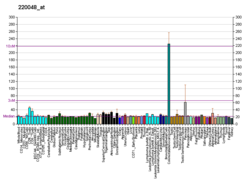
گیرنده اکتودیسپلاستین A
Другие языки:
گیرنده اکتودیسپلاستین A
Подписчиков: 0, рейтинг: 0
گیرنده اکتودیسپلاستین A (انگلیسی: Ectodysplasin A receptor) یک پروتئین است که در انسان توسط ژن «EDAR» کُدگذاری میشود. این پروتئین نوعی گیرندههای سطح سلول برای اکتودیسپلاستین A که نقش مهمی در رشد و نمو بافتهای اکتودرمی همچون پوست ایفا میکند. به لحاظ ساختاری، این پروتئین جزئی از ابرخانواده گیرندههای فاکتور نکروز تومور است.
ژن سازندهٔ این پروتئین در شکل بینی، گوش، دندان، بافت مو و میزان بیرونزدگی چانه نقش دارد.
اهمیت بالینی
جهش در این ژن سبب بروز بیماری ژنتیکی دیسپلازی اکتودرمی هایپوهیدروتیک میشود که مشخصهاش تعداد اندک غدد عرقی در بدن است.
- مشارکتکنندگان ویکیپدیا. «Ectodysplasin A receptor». در دانشنامهٔ ویکیپدیای انگلیسی، بازبینیشده در ۱۵ فوریه ۲۰۲۱.
برای مطالعهٔ بیشتر
- Thesleff I, Mikkola ML (May 2002). "Death receptor signaling giving life to ectodermal organs". Science's STKE. 2002 (131): PE22. doi:10.1126/stke.2002.131.pe22. PMID 11997580. S2CID 36068881.
- Ho L, Williams MS, Spritz RA (May 1998). "A gene for autosomal dominant hypohidrotic ectodermal dysplasia (EDA3) maps to chromosome 2q11-q13". American Journal of Human Genetics. 62 (5): 1102–6. doi:10.1086/301839. PMC 1377096. PMID 9545409.
- Kumar A, Eby MT, Sinha S, Jasmin A, Chaudhary PM (Jan 2001). "The ectodermal dysplasia receptor activates the nuclear factor-kappaB, JNK, and cell death pathways and binds to ectodysplasin A". The Journal of Biological Chemistry. 276 (4): 2668–77. doi:10.1074/jbc.M008356200. PMID 11035039.
- Yan M, Wang LC, Hymowitz SG, Schilbach S, Lee J, Goddard A, de Vos AM, Gao WQ, Dixit VM (Oct 2000). "Two-amino acid molecular switch in an epithelial morphogen that regulates binding to two distinct receptors". Science. 290 (5491): 523–7. doi:10.1126/science.290.5491.523. PMID 11039935.
- Elomaa O, Pulkkinen K, Hannelius U, Mikkola M, Saarialho-Kere U, Kere J (Apr 2001). "Ectodysplasin is released by proteolytic shedding and binds to the EDAR protein". Human Molecular Genetics. 10 (9): 953–62. doi:10.1093/hmg/10.9.953. PMID 11309369.
- Koppinen P, Pispa J, Laurikkala J, Thesleff I, Mikkola ML (Oct 2001). "Signaling and subcellular localization of the TNF receptor Edar". Experimental Cell Research. 269 (2): 180–92. doi:10.1006/excr.2001.5331. PMID 11570810.
- Headon DJ, Emmal SA, Ferguson BM, Tucker AS, Justice MJ, Sharpe PT, Zonana J, Overbeek PA (2002). "Gene defect in ectodermal dysplasia implicates a death domain adapter in development". Nature. 414 (6866): 913–6. doi:10.1038/414913a. PMID 11780064. S2CID 4380080.
- Yan M, Zhang Z, Brady JR, Schilbach S, Fairbrother WJ, Dixit VM (Mar 2002). "Identification of a novel death domain-containing adaptor molecule for ectodysplasin-A receptor that is mutated in crinkled mice". Current Biology. 12 (5): 409–13. doi:10.1016/S0960-9822(02)00687-5. PMID 11882293. S2CID 9911697.
- Sinha SK, Zachariah S, Quiñones HI, Shindo M, Chaudhary PM (Nov 2002). "Role of TRAF3 and -6 in the activation of the NF-kappa B and JNK pathways by X-linked ectodermal dysplasia receptor". The Journal of Biological Chemistry. 277 (47): 44953–61. doi:10.1074/jbc.M207923200. PMID 12270937.
- Shu H, Chen S, Bi Q, Mumby M, Brekken DL (Mar 2004). "Identification of phosphoproteins and their phosphorylation sites in the WEHI-231 B lymphoma cell line". Molecular & Cellular Proteomics. 3 (3): 279–86. doi:10.1074/mcp.D300003-MCP200. PMID 14729942.
- Zhang Z, Henzel WJ (Oct 2004). "Signal peptide prediction based on analysis of experimentally verified cleavage sites". Protein Science. 13 (10): 2819–24. doi:10.1110/ps.04682504. PMC 2286551. PMID 15340161.
- Hashimoto T, Cui CY, Schlessinger D (Apr 2006). "Repertoire of mouse ectodysplasin-A (EDA-A) isoforms". Gene. 371 (1): 42–51. doi:10.1016/j.gene.2005.11.003. PMID 16423472.
- Chassaing N, Bourthoumieu S, Cossee M, Calvas P, Vincent MC (Mar 2006). "Mutations in EDAR account for one-quarter of non-ED1-related hypohidrotic ectodermal dysplasia". Human Mutation. 27 (3): 255–9. doi:10.1002/humu.20295. PMID 16435307. S2CID 32110651.
- Tariq M, Wasif N, Ahmad W (Jul 2007). "A novel deletion mutation in the EDAR gene in a Pakistani family with autosomal recessive hypohidrotic ectodermal dysplasia". The British Journal of Dermatology. 157 (1): 207–9. doi:10.1111/j.1365-2133.2007.07949.x. PMID 17501952. S2CID 310090.


